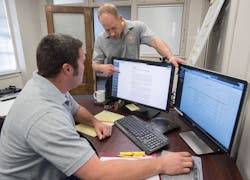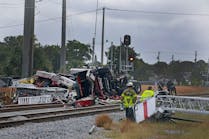As the recently elected second vice president of the International Society of Fire Service Instructors (ISFSI), I’ve been thinking about the variety of fire service training that’s offered throughout the world and have come to the realization that it’s changing, and will always continue to do so. As proof, simply consider education around the world today: Our children’s textbooks have been replaced by tablets and e-readers. Paper and pen have been replaced by instant student response systems, and folders and notebooks have been replaced by thumb drives and cloud storage. So as education changes around us, it forces the fire service to change as well, because if we don’t, we’ll be left in the dark. Just because a certain strategy or tactic worked 20 years ago doesn’t mean it’s still going to work today.
As we all know, firefighter training is the most important aspect of our job, next to emergency response. The late Chief John Eversole of the Chicago Fire Department summed it up best when he said, “Nobody calls the fire department and says, ‘Send me two dumb-ass firemen in a pick-up truck.’ In three minutes, they want five brain-surgeon decathlon champions to come out and solve all their problems.” This quote could not be truer today, not only because the world has changed from just a decade ago, but also because the fire service has become a truly all-hazards agency that must be able to provide effective customer service to Mrs. Smith, no matter the type of emergency. If her house is on fire, or she’s trapped in a crashed vehicle or a trench, or she’s having a heart attack, or she spilled chlorine by her pool, or has a water or gas leak, or she’s having a carbon monoxide emergency, we are expected to mitigate the problem—and that’s where optimal training comes into play.
The flipped classroom
In the past, firefighter training was led by an instructor or company officer inside a classroom or on the drill ground. Everyone came to a central location, and in some cases, they were allowed to mark out of service during training. Unfortunately, those days are gone. As the complexity of the fire service increases, and more demands are placed upon us, training can no longer be organized in this manner. Instead, training today involves many other facets, such as Web-based exercises.
Training has already become more “Web-based”; however, one common complaint I hear from firefighters is that they want less Web-based training and more hands-on training. I do believe that there is a time and a place for Web-based training, but within reason. Good instructors will use Web-based training to “flip” the fire service classroom. Flipped learning is a form of blended learning where students learn new content by watching online video lectures, usually from home. The assignments that used to be given as homework are now done in class, with teachers offering more personalized guidance and interaction with students, instead of lecturing. This strategy is also known as a backward classroom, reverse instruction, flipping the classroom and reverse teaching.
Flipping the classroom can take place on many levels using commercially available products and services, or it can be as simple as watching a YouTube channel. One in particular is the Penn Township (Mishawaka, Ind.) Fire Department’s channel, which can be found at www.YouTube.com/PennFireTraining. I also encourage you to look at the Kahn Academy “Flipping the Classroom” video on TED to learn more about the flipped classroom approach to training.
No substitute for the CO
The flipped classroom is perfect for “pre-loading” skill drills so that students get more hands-on time on the drill ground. It’s also perfect for conducting OSHA safety training and disseminating other information that doesn’t necessarily have to be provided in a classroom format. But we must remember that online training or a learning management system is never a replacement for a training officer, an instructor or drill ground firefighter skills. Wearing SCBA, pulling hose and throwing ladders, along with fire attack, rapid intervention and mayday drills, need to remain the primary means of sharpening our skills.
Company-level training in particular must be our focus as the fire service moves forward, because the most important training officer we have is the company officer (CO). No one knows the needs of their company better; therefore, the CO must be a highly effective leader in the firehouse when it comes to training and drills. The CO must own training and make sure every day is a training day.
COs should also be familiar with how to conduct member needs assessments, as well as how to develop lesson plans, deliver training and evaluate skills. Performance levels must be documented on Job Performance Requirement skill sheets and must always include reference to a specific NFPA standard, such as 1001, 1021, 1410, etc. If looking for drill ideas, COs should check out firefighterclosecalls.com/weeklydrills.php for hundreds of free, downloadable drills.
The drillmaster of this site, Forest Reeder, has also built out the company and multi-company drills that adhere to NFPA 1410: Standard on Training for Emergency Scene Operations. NFPA 1410 provides fire departments with an objective method for measuring employees’ performance of initial fire suppression and rescue procedures during emergency scene operations. Note: NFPA 1410 drills should be completed annually by all department members to establish a training baseline.
Simulation-based training
Another great fire service training resource in today’s world is simulation-based training. There are many great programs on the market today that you can easily load onto your tablet and take out to the street; from there, you can add photos of local buildings, residential areas, etc., and perform simulations. Just remember, you don’t need an expensive command training center to do simulation-based training; a simple tablet and an app are all you need. Hours of tactical discussion and learning can be had from simulation-based training; we just need to fully realize and understand that simulation-based training is not a video game or a way to set our members up for failure through hazing. Everyone makes mistakes, so learn from them and adjust your tactics accordingly.
The science of firefighting
While I believe we are still in a fire service “civil war” over the scientific research that’s taking place currently regarding structural firefighting, we all must come to realize that, in the words of astrophysicist Neil DeGrasse Tyson, “The good thing about science is, it is true whether you like it or not.” To put it another way, the science of firefighting, such as the significance of the fire triangle and the fire tetrahedron, is not going away.
Right now, all of the Firefighter I/II textbooks are being re-written to include the latest scientific findings. Officer training in some states is now including the science as part of firefighting strategy and tactics. I think we wouldn’t be in the boat that we’re in today with fire science research and tactics, had we just understood the importance of the fire triangle and fire tetrahedron much earlier. When we look at those very simple aspects of fire, we should realize that the only two ways we really have of combating it is to either remove or limit the air it receives, or remove the heat through cooling. As the great Tom Brennan said, “Put out the fire, and the rest of your problems will go away.”
Live-fire training
Unfortunately, I see the future of live-fire training as troubling. As environmental protection standards increase, it will become increasingly more difficult to burn Class A fuels and almost impossible to burn acquired structures. Live-fire training is one of the most important types of training we have, yet those who govern our air quality don’t necessarily agree; therefore, we must make our case for safe live-fire training that follows NFPA 1403; Standard on Live-Fire Training Evolutions.
That said, since the inception of NFPA 1403, 16 firefighters have been killed in the line of duty during live-fire training. With statistics like these, it’s much easier for the naysayers to make the case against live-fire training. As firefighters, we need to be able to train in a realistic environment; simulated smoke and fire only go so far. Just as the military uses live ammunition and bombs on their ranges for training, we too must be able to conduct training that includes dangers similar to situations we face in the real world if we are to ever be properly prepared to save lives and mitigate other emergencies.
The future is now
While we would all love to be able to just do “firefighter training,” we must realize that in the future, our role of “all-hazard” responders will continue to grow. EMS will evolve to include not only scene-based care and transport, but also community paramedicine. We’re already seeing evidence of this in communities across the United States.
Additionally, our role in hazmat response, as well as terrorism-based events, will continue to grow as society changes. As natural resources grow scarcer, more and more chemically engineered products will be developed, creating not only new hazmat response issues, but also increased fire loads and new attack issues.
Mass-causality incidents have now become the norm, especially in the active shooter arena. Integration with law enforcement will have to become a huge focus during training, especially in the realms of incident command and rescue task force protocol. Technical rescue will also continue to play an important part of our training as more construction occurs across the country, and natural disasters increase due to our ever-changing weather patterns.
The future of fire service training, folks, is now, so we must all embrace changes in learning and, most of all, delivery of education. Today’s student is more connected than ever, so if we don’t provide them with up-to-date training, they’ll seek it out on their tablet, smartphone or computer, and what they find may not necessarily be correct.
Lastly, we must remember, as we enter the future of fire service training, to never forget where we have come from and that hands-on training must continue to be our primary form of firefighter training. As firefighters, company officers, chiefs and training officers, the most important job we have when it comes to protecting the future of the fire service is to embrace change.
When you think about it, there’s no excuse in today’s “connected” environment for not learning something new about our job every single day. Remember: Websites such as www.Firehouse.com, www.FirefighterCloseCalls.com and www.ModernFireBehavior.com are updated daily and provide a plethora of information that can help us do our jobs safer and better. We owe it to Mrs. Smith to be better today than we were yesterday and to continuously grow in our careers. For her sake, let’s make the old saying, “Every day is a training day” not just something we say, but something we truly live each time we enter the firehouse.






